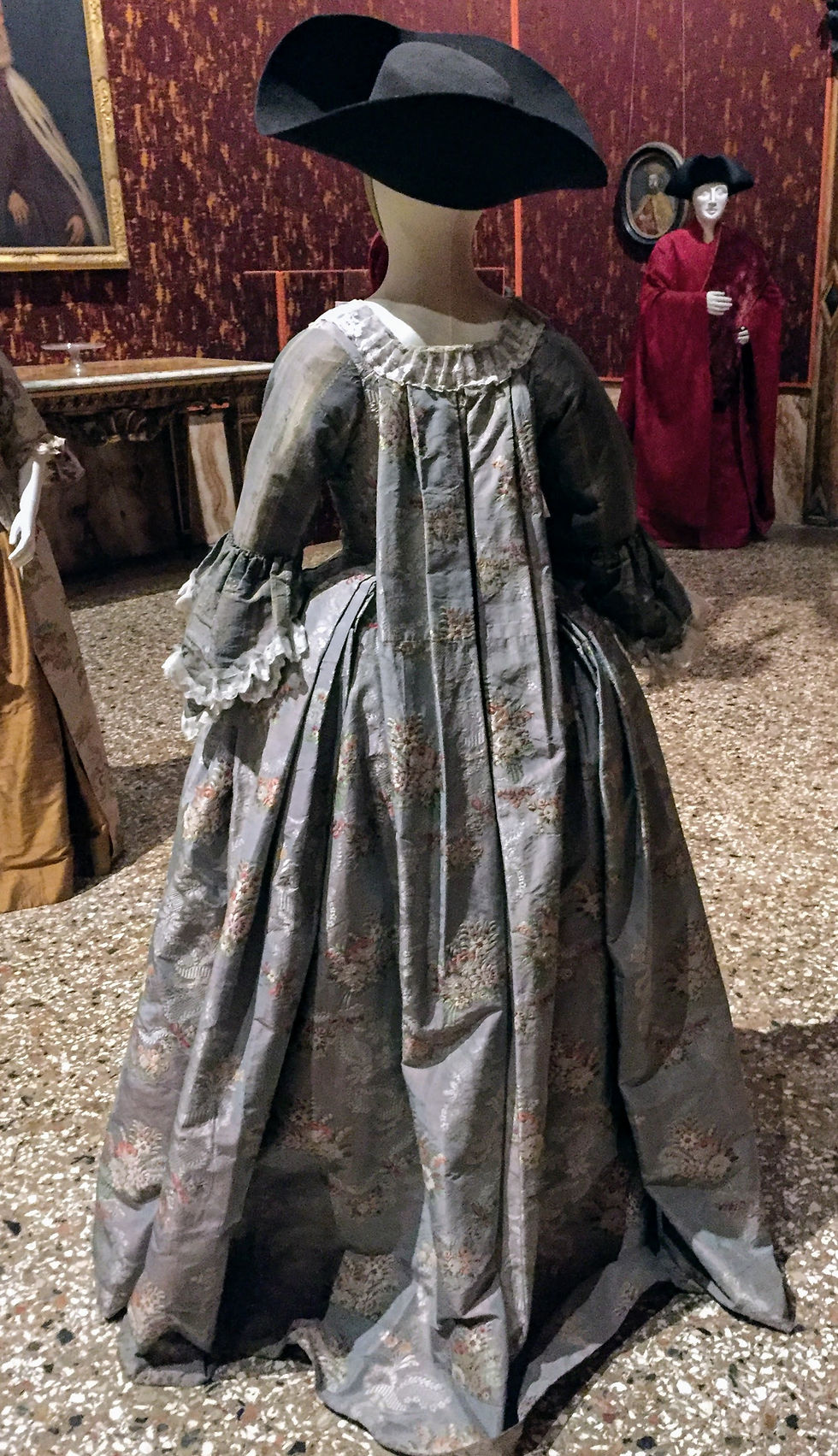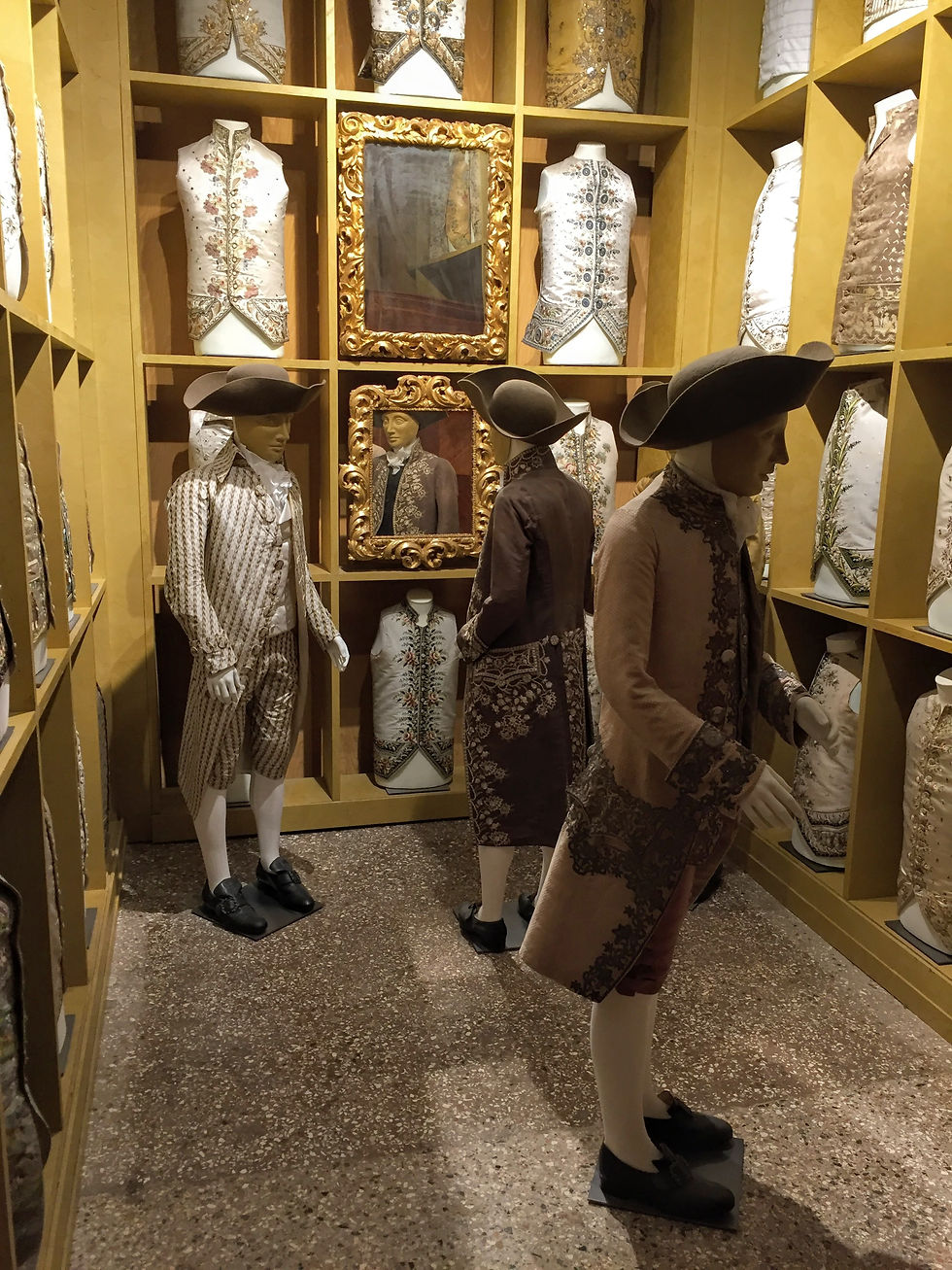Palazzo Mocenigo Review.
- Jaclyn Schutjer

- Feb 23, 2017
- 3 min read
In the 18th century, Venice was a center of fashion for European courts. Museum Palazzo Mocenigo, located in the center of Venice, depicts the typical trends worn during this time period. The majority of the garments on display in the museum are Venetian-made men’s tailcoats and trousers, as well as women’s gowns.


The women’s 18th century garments on display showed full skirts with immense hip accentuation. To create this look, women wore pocket-hoop panniers under their petticoats in order to exaggerate their hip width. To complete this over exaggeration of the female body women also wore corsets, or stays, to minimize the width of their waist in comparison to their hips. This established the iconic female conical shape of this century.

On top of the panniers was a layer called the petticoat. The petticoat is a pleated skirt which added an additional layer of fullness to the gown. The petticoat was usually embroidered or constructed of an ornate fabric to match the top layer of the ensemble, called the gown. The gown typically consisted of a connecting skirt and bodice. The skirt of the gown was usually constructed to be open in the front, allowing the petticoat to be displayed underneath. Sometimes the bodice of the gown consisted of a third connecting piece called the stomacher. The stomacher was a triangular piece of fabric covering the corset and was usually the same pattern as the rest of the gown. It was held in place with hooks and eyes.

The garments displayed in the museum had a box-shaped plunging neckline. The corseted waist collected at the center to create a V-shape dip. The sleeves were ruffled, often with lace, and hit just below the elbow.
Women of this time period also wore the sack-back gown (robe à la française). This gown was very similar to the others worn during this period but had one difference, a small train. It was connected to the shoulders of the gown and arranged in box pleats to create a loose waterfall movement of the train.
Although this was not shown on the museum mannequin, mob caps were very popular in the 18th century to top off this look. Usually crafted of linen, cotton, or lace, this garment served to protect women’s hair from everyday dirt and dust. It was also worn as a way to acceptably cover hair when it was not fully styled. It was also popular for women to wear powdered wigs. These wigs were usually styled in a collected up do.
The exception to these styles were the Courtesans. Initially courtesans blended with the style of typical venetian women, but eventually rebelled from the fashion laws and became very distinguishable with their implementation of many new fashion trends. These trends consisted of pearl necklaces, excessive lace, bleached hair, and low-cut garments, with their stomach often exposed.

Men’s and women’s clothing from this time were typically constructed of velvet, silk, linen, cotton or lace textiles. One of the main indicators of garments from this time is the reflective sheen and bold floral and striped designs of the garments. Women’s gowns were also covered in ornate ruffles, bows, and lace.
Men’s fashion trends consisted of many layers. The cravat was a band of fabric worn around the neck. Often made of lace, this forerunner to the necktie added a pop of texture peeking out of the frock coat. The frock coat was a knee length outer coat consisting of immense embroidering and embellishment.
The men’s garments on display in the Museum Palazzo Mocenigo were from the late 18th century, thus, the frock coats of these garments had a much straighter silhouette than the fuller, pleated garments of the early 18th century. Waist coats were worn underneath the frock coat. The waist coat during this time was cut to the natural waist, similar to those we see today. Underneath the waist coat men wore a shirt made of linen and designed with frills. On the bottom half of the ensemble, men wore breeches. These breeches were styled to hit just below the knee and were met at the knee by stocking in order to fully cover the leg. This silhouette was very specific to the late 18th century. Finally, this trend was finished with a powdered wig. Wigs of this time usually collected in a curled ponytail and were topped with a tricorn hat.







Comments